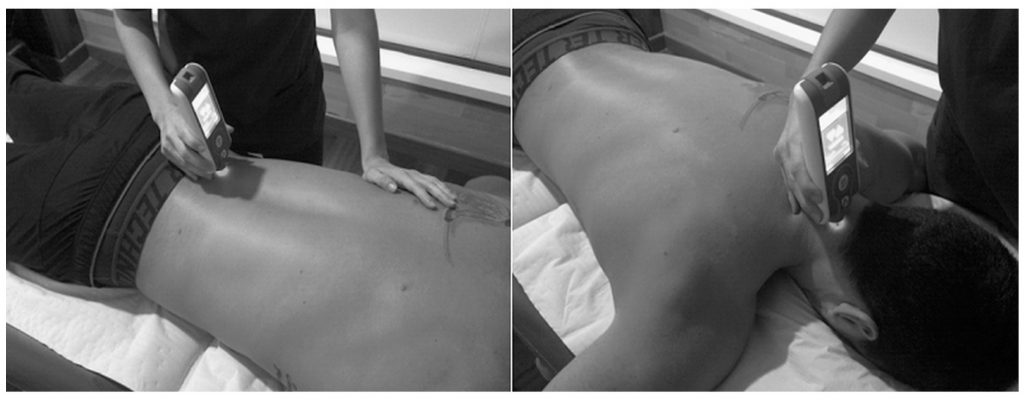Publications

Mechanical Properties of Lumbar and Cervical Paravertebral Muscles in Patients with Axial Spondyloarthritis: A Case-Control Study
Authors: Juan L. Garrido-Castro 1, I. Concepcion Aranda-Valera 1 ,2, 3, Jose Pena-Amaro 1, 4, Alfonso Martinez-Galisteo 5, Cristina Gonzalez-Navas 1, Daiana P. Rodrigues-de-Souza 6, Sandra Alcaraz-Clariana 6, Lourdes Garcia-Luque 6, Iago R. Martinez Sanchez 7, Clementina Lopez-Medina 1, 2, 3, Eduardo Collantes-Estevez 1, 2, 3, Francisco Alburquerque-Sendin 1, 6
Affiliations:
- Maimonides Biomedical Research Institute of Cordoba (IMIBIC), 14004 Cordoba, Spain
- Department of Rheumatology, University Hospital Reina Sofía, 14004 Cordoba, Spain
- Department of Medical and Surgical Sciences, University of Cordoba, 14004 Cordoba, Spain
- Department of Morphological and Social Health Sciences, University of Cordoba, 14004 Cordoba, Spain
- Faculty of Veterinary, University of Cordoba, 14014 Cordoba, Spain
- Department of Nursing, Pharmacology and Physical Therapy, University of Cordoba, 14004 Cordoba, Spain
- Advanced Informatics Research Group (GIIA) TIC-252, University of Cordoba, 14014 Cordoba, Spain
Journal: Diagnostics - September 2021, Volume 11, Issue 9, Article no. 1662 (DOI: 10.3390/diagnostics11091662)
-
Field & Applications:
- Medical
- Musculoskeletal disorder
- Rheumatology
- Validity
Background: Axial spondyloarthritis (axSpA) affects spinal muscles, due to inflammation and structural damage. The mechanical properties of the muscles, such as tone or stiffness, could be altered in axSpA. The aim of this work is to analyze the mechanical properties of cervical and lumbar spine muscles in axSpA patients and their relationship with metrology measures, function, disease activity, structural damage and quality of life.
Methods: axSpA patients and age/gender/BMI matched healthy controls were recruited. The muscle mechanical properties (MMPs), such as tone or frequency, stiffness, decrement (linear elastic properties), relaxation and creep (viscoelastic properties), of cervical (semispinalis capitis) and lumbar (erector spinae) muscles were bilaterally measured at rest using myotonometry. Additionally, conventional metrology, BASMI (metrology index), BASDAI (disease activity index), mSASSS (radiological structural damage index) and SF-12 (health-related quality of life questionnaire) were used in the axSpA group. Between-groups comparison, intra-group correlations and multivariable regression analyses were performed to achieve the study aims.
Results: Thirty-four axSpA patients (mean age: 46.21 ± 8.53 y) and 34 healthy volunteers (mean age: 43.97 ± 8.49 y) were recruited. Both in cervical and lumbar spine, linear elastic parameters were significantly higher in axSpA patients in comparison with controls, while viscoelastic parameters were significantly lower. Lumbar muscle frequency, stiffness, relaxation, creep and cervical muscle elasticity were fair to strongly correlated (|0.346| < r < |0.774|) with age, functional status, activity of disease, structural damage and quality of life in axSpA patients. Furthermore, moderate to good fitted multivariate models (0.328 < R2 < 0.697) were obtained combining age, conventional metrology, activity of the disease and function for the estimation of cervical and lumbar MMPs.
Conclusion: Mechanical properties of spinal muscles of axSpA patients differ from controls. Lumbar and cervical muscles exhibit greater linear elastic properties and lower viscoelastic properties, which are related with age, clinical and psychophysiological features of axSpA.

Figure 1. Procedure for measuring lumbar (left) and cervical (right) muscles using MyotonPRO©.
Keywords: axial spondyloarthritis, cervical muscles, lumbar muscle, muscle tonus, rehabilitation
In conclusion, cervical and lumbar paraspinal muscle tone, stiffness (linear elastic properties) and lower relaxation and creep (viscoelastic properties), evaluated using a myotonomotry device, was altered in axSpA when compared to healthy individuals. These mechanical characteristics were related to age, functional status, activity of disease, structural damage and quality of life, in a higher intensity for lumbar region. The physiopathological and clinical implications of these abnormalities merit further research.


